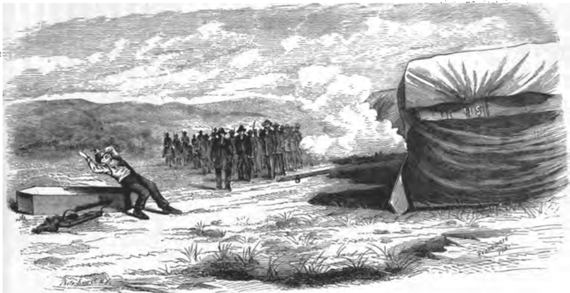
*Callie Vandewiele [2014] is doing a PhD in Latin American Studies and was born in Utah. Picture: "Execution of John D. Lee" by J.P. Dunn, Massacres of the Mountains: A History of the Indian Wars of the Far West, New York: Harper & Brothers. Licensed under Public Domain via Wikimedia Commons. John D. Lee was executed for his role in the Mountain Meadows Massacre of 1857.
On March 23, 2015 Utah Governor Gary R. Herbert signed a law reinstating the firing squad as a method of execution. With state after state postponing lethal injections because of problems sourcing the required drugs, Herbert declared that Utah needed another option.
From Ohio's botched executions, to the sheer volume of people executed each year in Texas, it's not a surprise that more and more people are asking if the government even has the right to take a human life. It isn't unexpected then that there is an outcry when Utah proposes something as old-fashioned and barbaric as standing a person in front of a wall and shooting them. How could anyone consider the firing squad today? In the 21st century? What gives Utah the right, or even the idea, that citizen volunteers can and should pick up rifles and kill a human being in the name of the state?
But it's not so bizarre in Utah as one might expect...Utah has a long and unique history with the firing squad and only banned its use in 2007. In Utah, the use of the death penalty, firing squad and Mormonism are all connected by a little known doctrine from the early years of the faith - known as Blood Atonement.
The roots of Blood Atonement go back to the very earliest days of the Mormon fatih. In some ways the Mormon Church of the mid to late 19th century is very similar to the Mormon Church of today, but in others the Mormonism of that period is not a Mormonism that we could easily recognise. Early Mormons were a tight knit group, and they followed first Joseph Smith Jr. and then Brigham Young across the United States, settling in Ohio, Missouri and Illinois. From active violent clashes with other locals (Missouri Mormon War) to bloc-voting and cultural mismatches on topics such as polygamous marriage, Mormons proved to be very difficult neighbours. Finally, in 1847 Mormon pioneers headed west to the empty desert in the shadow of the Rocky Mountains. By 1850 Utah was declared a territory of the United States and Brigham Young its territorial governor.
From its inception, the Utah Territory, under Mormon leadership, became an experiment in theocracy as Mormons toyed with a theory of government espoused by the late Joseph Smith Jr. called "Theodemocracy" that blended a Republic style government with a church-led theocratic leadership. Between 1857 and 1858 Utah attempted an ill-fated and short-lived secession from the United States. By 1859 the Mormon experiment in theodemocracy had ended with the arrival of US army troops. Brigham Young was unceremoniously removed from his position as territorial governor, and the Mormon church was left to lick its wounds and reorganise as the armies were called back east at the start of the US Civil War. Short-lived as it might have been, that experiment in theodemocracy would leave a series of lasting marks on the state's culture and governance.
Death penalty
And when it comes to the death penalty theodemocracy did indeed leave a mark. Controversial from the start, Blood Atonement stated that murdering an innocent was so horrific that the Christian doctrine of atonement through the blood of Christ would not be possible - anyone who committed murder was then immediately doomed to suffer eternal torment. Brigham Young taught that these sins could only be forgiven if the perpetrator was willing die in such a way that their blood spilled onto the ground - calling it Blood Atonement. If their blood was shed as a voluntary sacrifice, they would then regain the place in heaven that they had lost. Providing Blood Atonement was a gift to the sinner - giving back their place in heaven. Denying it by either letting the sinner live, or killing them in a way that did not involve shedding blood onto the ground, meant sentencing someone to the worst level of hell. Although Brigham Young, and following Church prophets and presidents were never again theocratic government leaders, execution by firing squad became - and remained - the preferred choice for many inmates among the short and brutal list of options, including (over the years) hanging and lethal injection, none of which involved spilling blood.
In 1978, Mormon Church Doctrine underwent an overhaul as Mormonism modernised. In this transformation of Church law, one of the doctrines that was quietly deleted from old texts was Blood Atonement. Utah's government still hung onto the firing squad as a method of execution until 2007, when it was phased out. For Utah, the death penalty remains as much a debate as anywhere in the country. However, as Governor Herbert weighed into that conversation, by giving his state more options given the difficulties with lethal injection, he was also (knowingly or not) playing a part in Utah's unique and theocratic history of capital punishment. A reminder that sometimes our history, and the weird things wrapped up in that history, aren't all that far behind us - and that we, like Utah, may accept things that shock the rest of the world but seem pretty darn normal to us.
